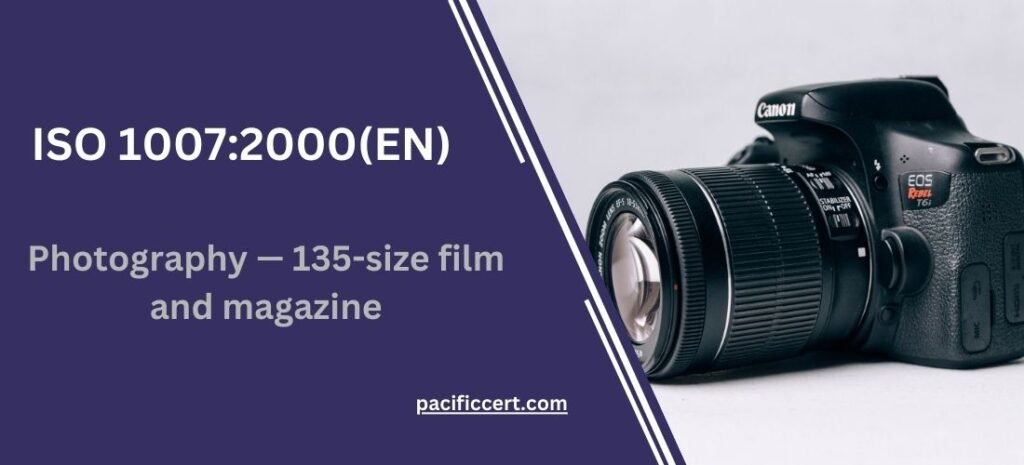
What is ISO 1007:2000 Photography -135-size film and magazine?
ISO 1007:2000 Photography pertains to the specifications for 135-size film and magazines used in photography. The 135 film format is a widely used film format for still photography. It was initially introduced by Kodak in 1934 and has since become a standard in the industry. The ISO 1007:2000 standard outlines the dimensions, tolerances, and other technical characteristics that 135-size film and magazines should meet to ensure compatibility and functionality across different cameras and processing systems.
The standard is particularly important for manufacturers of cameras, film, and photographic equipment, as well as for film processing labs. By adhering to the ISO 1007:2000 standard, these entities can assure consumers that their products will be compatible with one another, thereby fostering trust and reliability in the market.
The importance of such standardization cannot be overstated. In the absence of a universally accepted standard like ISO 1007:2000, manufacturers might produce film and cameras with slightly different specifications, leading to compatibility issues. This could result in poor image quality, or even damage to the film or camera. For instance, if a film is too thick or too thin compared to what the camera is designed for, it could jam the camera or result in uneven exposure.
In summary, ISO 1007:2000 serves as a critical benchmark for quality and compatibility in the realm of 135-size film photography. It provides a set of guidelines that manufacturers and processing labs can follow to ensure their products meet certain minimum requirements, thereby ensuring interoperability and maintaining high standards within the industry.
What are the requirements for ISO 1007:2000?
ISO 1007:2000 Photography sets forth a range of technical requirements aimed at ensuring compatibility, quality, and performance across different brands and types of cameras, film, and photographic equipment. While I cannot provide the full text of the standard due to copyright reasons, I can outline some general areas that such a standard typically covers:
Dimensions and Tolerances
- The standard specifies the exact dimensions of the 135-size film, including its width, length, and perforation size and spacing.
- Tolerances for these dimensions are also defined to ensure that the film can be easily and reliably loaded into any camera designed for this format.
Material Properties
- The standard may specify the type of material to be used for the film base, such as cellulose acetate or polyester.
- Properties like thickness, tensile strength, and transparency could also be defined.
Perforations
- The standard outlines the size, shape, and spacing of the perforations along the edges of the film, which engage with the camera’s sprocket mechanism for advancing the film.
Magazine Specifications
- The standard also covers the dimensions and material properties of the film magazine or cartridge, ensuring that it fits securely and operates correctly in cameras designed for 135-size film.
Markings and Labeling
- Information that should be present on the film or magazine, such as film speed, type, and number of exposures, might also be standardized.
Quality Control
- There may be requirements for quality assurance and testing to ensure that the film and magazine meet the standard’s specifications.
Interoperability
- The standard ensures that films and magazines that comply with it are compatible with all cameras and equipment also designed to this standard.
In summary, ISO 1007:2000 provides a comprehensive set of requirements aimed at standardizing the key aspects of 135-size film and magazines. By adhering to these specifications, manufacturers can ensure that their products are of high quality and are compatible with other products in the market, thereby fostering consumer trust and facilitating the smooth functioning of the photographic ecosystem.
What are the benefits of ISO 1007:2000 Photography?
ISO 1007:2000 Photography several benefits to various stakeholders, including manufacturers, photographers, and even consumers. Below are some of the key advantages:
Standardization and Compatibility
- Interoperability: The standard ensures that 135-size film and magazines from different manufacturers are compatible with each other and with various camera models designed for this format. This is crucial for photographers who may use different brands of film and cameras.
- Ease of Use: Standardization simplifies the process of selecting and using film and cameras, as photographers can be confident that any ISO 1007:2000-compliant film will work with any compliant camera.
Quality Assurance
- Consistent Quality: The standard sets minimum requirements for various aspects like material properties, dimensions, and tolerances, ensuring a baseline level of quality across products.
- Reliability: Adherence to the standard ensures that the film and magazine will function as expected, reducing the likelihood of issues such as film jamming or tearing.
Market Benefits
- Consumer Trust: Standardization fosters trust among consumers, as they can be assured of the quality and compatibility of products adhering to ISO 1007:2000.
- Global Market Access: Compliance with an internationally recognized standard can make it easier for manufacturers to enter and compete in global markets.
Innovation and Development
- Basis for Innovation: While the standard sets minimum requirements, it also serves as a foundation upon which manufacturers can innovate, adding features or improving quality beyond the standard specifications.
- Industry Collaboration: The process of developing and updating ISO standards often involves input from various industry stakeholders, fostering collaboration and sharing of best practices.
Cost Efficiency
- Reduced Costs for Manufacturers: Standardization can lead to economies of scale, as manufacturers can produce film and magazines to a single set of specifications, reducing the cost of design and production.
- Cost Savings for Consumers: The compatibility ensured by the standard can also result in cost savings for consumers, as they are not locked into using film and magazines from a single manufacturer.
In summary, ISO 1007:2000 provides a framework that benefits the entire ecosystem surrounding 135-size film photography. It ensures that products meet certain minimum quality and compatibility requirements, thereby fostering consumer trust, encouraging market competition, and serving as a foundation for further innovation.
Who needs ISO 1007:2000?
ISO 1007:2000 Photography is relevant to a variety of stakeholders within the photography ecosystem. Here’s a breakdown of who might need this standard and why:
Manufacturers
- Film Producers: Manufacturers of 135-size film need to adhere to the standard to ensure their products are compatible with cameras designed for this format.
- Camera Manufacturers: Those who produce cameras designed for 135-size film also benefit from the standard, as it ensures that any compliant film will work with their cameras.
- Accessory Manufacturers: Companies that produce related accessories, such as film canisters or film processing equipment, may also find the standard useful for ensuring compatibility.
Photographers
- Professional Photographers: Professionals who use 135-size film will want to ensure that both their film and cameras are compliant with ISO 1007:2000 to guarantee the best possible performance and image quality.
- Amateur Photographers: Even hobbyists benefit from the standard, as it simplifies the process of selecting compatible film and cameras, reducing the risk of equipment malfunction or poor image quality.
Retailers and Distributors
- Photography Stores: Retailers can more easily recommend products that are compatible with each other, thereby improving customer satisfaction and reducing returns.
- Online Marketplaces: E-commerce platforms that sell photography equipment can use the standard as a filter or category, helping customers make informed decisions.
Film Processing Labs
- Commercial Labs: These labs need to ensure that their equipment is compatible with films that adhere to ISO 1007:2000, as this will make up a significant portion of the film they process.
- Educational Labs: Institutions that teach photography will also find the standard useful for ensuring that students are working with compatible and reliable equipment.
Regulatory Bodies and Certification Agencies
- Quality Assurance Agencies: Organizations that certify the quality of photographic equipment may use ISO 1007:2000 as a benchmark.
- Customs and Trade Authorities: These bodies may require adherence to ISO standards, including ISO 1007:2000, as a condition for import or export of photographic equipment.
Consumers
- General Public: Even casual consumers who may not be well-versed in the technical aspects of photography benefit indirectly because the standard ensures that the products they purchase are of a certain quality and are compatible with each other.
In summary, ISO 1007:2000 serves a broad range of stakeholders by standardizing key aspects of 135-size film and magazines. This ensures quality, compatibility, and reliability across the board, benefiting everyone from manufacturers to end-users.
At last, Pacific Certifications is accredited by ABIS, you need more support with ISO 1007:2000 Photography, please contact us at +91-8595603096 or support@pacificcert.com
Read About: ISO 19111:2003-Geographic information







